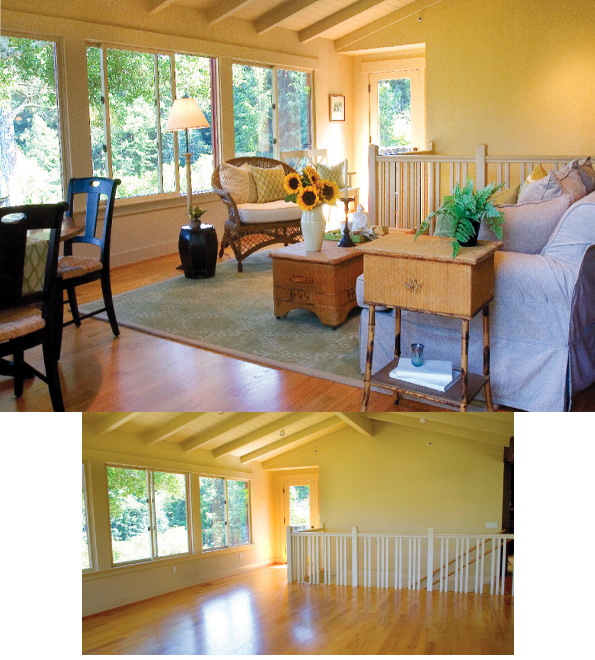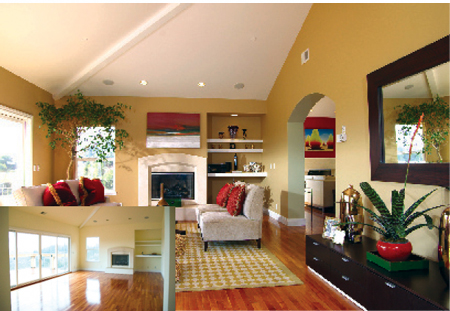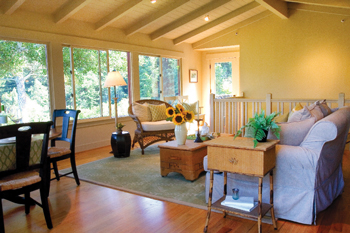
Lynn Scott and Landes Good create a warm and comfortable environment in a vacant house for sale
Staging a home for sale is like putting on its “evening makeup,” says Landes Good, a partner with Lynn Scott in Good-Scott Home Staging. “You want the house to be approachable, but you want to make it more dramatic, make it ‘pop.’”
Isn’t that what anyone trying to attract the right suitor might do? Particularly during a soft market, when a house can sit for months without getting a “second date,” a makeover can mean all the difference between waiting for the phone to ring and wearing one, so to speak.
Judy LeMarr of Frank Howard Allen Realtors knows that firsthand. She recently sold a Headlands condominium in Marin City that “was on the market forever,” she says. She couldn’t convince the owners to stage it, and so there it sat, even after a price reduction.
“Once they decided to stage it, though, it sold within a couple of weeks,” she says. “I will always use that condo as an example. If the owners had staged it right away, they would have sold it earlier and gotten more money.”
For LeMarr, it always makes sense to stage because “it defines a space and shows how much room there
really is. Prospective buyers don’t always have that vision. When you look at an empty space, it’s cold and you see the flaws, but you can’t see how you can live in it. “
On the other hand, house-hunters don’t want to see how the owner lives in it, either. “People feel awkward walking into someone else’s home and looking around,” says Good. “A stager helps a buyer bond with the home, linger and picture himself there. We’re selling a newer and better lifestyle, the idea that the buyer will have time to relax and enjoy life, so we make sure there’s no visual noise of clutter, bills or toys.”
Like other stagers, Good takes her cue from the home, not the home owners. “We aren’t staging their dream home,” she says.
“We’re making their home appeal to as many people as possible through straight-out good design.”
Interior designer and stager Ruth Livingston, who owns Ruth Livingston Studio on Tiburon’s historic Ark Row, would agree. “To me, it’s about the lifestyle. You want prospective buyers to visualize themselves and their family in the space and, depending on the environment, you want to create as much excitement, coziness, tranquility, or glamour as you can.
“If you’re talking about a Cape Cod or cottage-style house in Kentfield or Ross, I would probably do a shabby chic interior with antiques, sisal rugs, and canvas-slipcovered furniture,” she says. “If it was a sophisticated, contemporary house in Tiburon, I would use beautiful works of art, handwoven silk rugs, unique handmade furniture and decorative objects from the collection at my store.” Livingston prefers to keep her presentation simple and striking, with “special touches that glamorize the experience, like beautiful towels, soaps, lotions and candles in the bathroom, professional cookware in the kitchen, and a mirror, towels and sports water in a mini-gym.”
Beauty and the Bottom Line

A recent Wanderley staging project. Before and after.
All this beauty comes at a price. Generally, stagers charge home owners a monthly fee, based on the size of the project, with a two-month minimum. After two months, the monthly fee is based on a percentage of the initial quote, which includes use of the furniture, its delivery and removal, and the stager’s design services. While most good stagers use pieces from their own warehouse inventory as opposed to rental furniture, they will also edit a home owner’s existing furnishings and accessories, putting the unused items in an off-site storage facility.
Depending on their skills, stagers can handle a range of redesign decisions, from simple accessorizing to staging just the front entrance and common rooms to fully re-outfitting the entire home, complete with paint, lighting and landscaping changes.
Some even oversee large construction projects. When Jimmy “Marin” Wanninger of Frank Howard Allen Realtors wanted to put his Corte Madera investment home on the market, he asked San Rafael stager Robert Federighi to direct a half-million-dollar renovation of the place. Before the project was completed, Wanninger had received an offer.
“Bob is a designer who’s not afraid to express his opinion, and he’s also very decisive about where to spend money and where not to. If you can get away with not painting a room, he’ll tell you,” Wanninger says.
Federighi, who caters to Marin’s youthful home buyers with hip colors and a Ralph Lauren–like flair, often tells clients, “I’m not just furnishing a house. I want the buyer to walk in and get the feeling that they just have to have it.” They may feel that way about the furniture, too. “Most home owners can’t even afford to furnish their homes the way he does when he stages one, and he’s got enough furniture to stage more than 40 houses at the same time,” Wanninger says. “If you stage with the world’s greatest furniture, you’re selling a house that looks as good as it could ever possibly look.”
When negotiations with a prospective buyer stalled on the Corte Madera house, Federighi staged the entire house for an additional five figures, and Wanninger planned to put it on the market. The night before that was supposed to happen, he invited the customer over for one last look. The house sold that night.
“Ideally, you want to create a house so that more than one person really wants it,” Wanninger allows. “Some people will choose to sit and wait for the price to drop, but you want to create a sense of urgency. Good staging might not get you two offers, but it will get you a better offer sooner.”
Can a house sell in today’s market without being staged? “Sure,” says Wanninger, “but as a rule, not as quickly or for as much money. In this county, more often than not, the higher the price of the house, the more likely that it’s been professionally staged.”
Style Secrets
For Jennifer Livingston of J. Livingston Home Decor, putting a home’s best foot forward is essential in today’s market of savvy young buyers with money. “If you are selling your house,” she says, “it’s important to respect your property and yourself and put the best product out there that you can.”
That means a home needs to “sparkle inside and out” and is often helped by an exterior pressure-washing, pristine floors and fresh paint. “Buyers should think that they’d be able to move in ‘as-is’ instead of asking themselves, ‘What do I have to do to live here in six months?’”
She pulls furnishings from her warehoused inventory and, like many stagers, opts to purchase new pieces rather than renting them and sacrificing on style. “I like to keep things casual, clean and livable with white slipcovered sofas, custom pillows, a fresh color palette and antiques for warmth. It’s really important to make it neutral and inviting so that people can see themselves living there.”
On the other hand, the Brazilian-born first-name-only Wanderley, of his eponymous staging firm, likes to infuse a space with color. “If you put a house on the market, it has to have a message,” he says. “You want people to leave thinking, ‘That was a beautiful house,’ not just a white house. It’s more exciting. An all-white house is boring and doesn’t make sense.”
His inventory of high-end classic-style furnishings, including several baby grand pianos and a pool table, is used purposefully.
“People often think of staging as just putting in furnishings to give scale to a room, but the right way is to make the house comfortable and make the buyer feel like staying. A stager goes into the parts of a house that are difficult to understand and shows how they can be used.”
And the staging should more than pay for itself, he adds. “If you have a $2 million home and spend $20,000 staging it, you should be able to sell it for $2.1 million,” he says. One client, told by a realtor that he could get $3 million for his Broadway apartment in San Francisco, decided to have Wanderley remodel it first for $500,000. He sold it within a week for more than $5 million.
“You do recoup your money,” Wanderley says. “I don’t know anything on the real estate market that is as profitable as staging; you can double your money in 60 days. If you look at it as an expense and not as an investment, you’re looking at it the wrong way. It’s a home improvement and it’s tax free.”
Staging Services
Robert Federighi Design, Construction and Staging
415.479.4794
robertfederighi.com
Good-Scott Home Staging
415.717.3558
good-scott.net
J. Livingston Home Decor
415.453.5538
jlivingstonhomedecor.com
Ruth Livingston Interior Design
415.435.5264
ruthlivingston.com
Wanderley Home Renewal & Staging
415.720.3831
wanderleystaging.com
Photos by Barbara Ries


